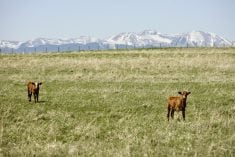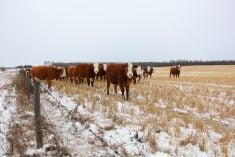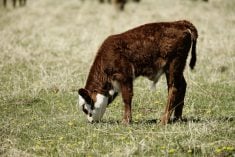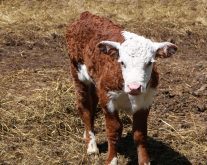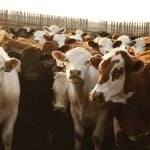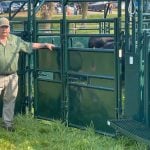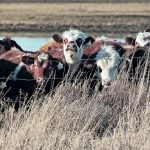Jim called one morning upset about two three-month-old Holstein steers he had bought at the local auction market two weeks earlier.
“I’m really sorry about calling. I know you have warned me about doing this, but calving season is over for me and everything went to pasture. They are really sick. Can you come out and see them?”
Jim had moved the calves to a small corral with a feed bunk and watering bowl in one corner and a wooden shelter across one end. One calf couldn’t rise. The other calf appeared blind, reluctant to move and stood pushing against the old barn wall with its head.
Read Also

Body condition, nutrition and vaccination for brood cows
One of the remarkable events of the past century related to ranching has been the genetic evolution of brood cows….
I asked Jim if he noticed anything about the wall around the feed bunk. He stood for a minute then said “All the paint is missing around the bunk and down the wall for several feet. I’ve noticed them licking the wall. Could old paint be causing the problem?”
“It’s not the paint, but what’s in it. I’m sure both calves are suffering from lead poisoning. I’ll take blood samples to be sure.”
“Why did we ever add lead to paint?” Jim asked.
“All I can say is it’s one of the most destructive and long-lasting things humans ever did and it happened over the last couple of hundred years.”
Added lead accelerates drying, increases durability, maintains a fresh appearance to paint and resists moisture that causes corrosion. Lead is one of the main health and environmental hazards associated with paint. Lead paint has been generally phased out due to its toxicity. Alternatives such as water-based paint and lead-free traffic paint are readily available.
Lead can be found in old car or tractor batteries, lead paint, boiled linseed oil, used engine oil, roofing materials and foliage in areas exposed to industrial waste. For some reason, young animals readily consume these materials.
Because of lead’s persistence and ubiquitous nature, regulatory agencies have tried to free the world of lead-containing substances, primarily to diminish children’s exposure to lead. Chronic ingestion of lead by children over time has been associated with delayed learning and neurological deficiencies.
As early as 1949, Maryland’s House of Delegates passed a bill banning the use of lead paint on children’s toys and furniture — a law repealed a year later due to industry pressure. Yet the battle continued.
Canada banned lead-based paint in 1976; the U.S. in 1978. Unfortunately, millions of previously painted homes and buildings continued to spew lead from paint and pipes into the environment. Car batteries, often recklessly disposed of in garbage dumps, continue to be a primary source of lead and poisoning in cattle.
Jim asked if animals suffering from lead poisoning could be treated. Food-producing animals suffering from lead poisoning should not be treated, but immediately euthanized and safely disposed of. Lead incorporated into bone takes years to clear. Accidental exposure of groups to lead can be a very disheartening and expensive experience. Chickens, consuming paint flecks around old buildings, can incorporate unsafe lead levels in eggs without showing clinical signs.
Ingested lead has a profound effect on enzyme systems in the body. Many types of cell systems are involved, affecting immunity and production of red and white blood cells. Capillaries throughout the body leak blood and fluid, affecting brain, liver and kidney function.
Bottom line:
- Treatment in food-producing animals should not be attempted.
- Lead poisoning is common.
- Old flaking paint can be a source of lead for cattle, chickens and children. c
– Dr. Ron Clarke is a veterinarian who consults on animal health and disease issues and writes for agricultural and veterinary audiences.





